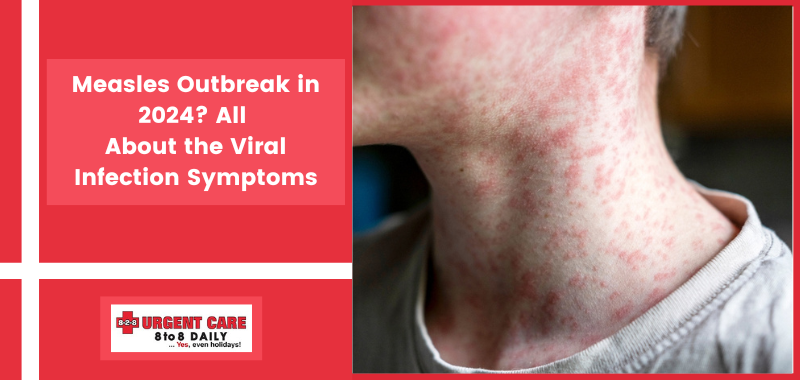


Measles is a contagious disease that can be spread through cough, cold, high fever, and rashes. It once took the world by storm, but now it can be prevented through vaccination.
Recently, the USA has seen an increase in the outbreak of measles. About 128 cases were reported in 20 jurisdictions by April 26, 2024. Reports show seven outbreak cases this year, as opposed to four outbreaks in 2023. At least six of the cases were reported in California. Staying alert and informed is vital to prevent measles symptoms in adults and children. Below, we will learn more about measles and its symptoms.
Measles mainly causes reddish spots and blemishes on the skin that can be itchy and painful. These marks begin with one’s face and spread to other body parts. Other viral infection symptoms include,
In rare cases, these symptoms can be contagious and might lead to severe health conditions like diarrhea, brain swelling, and pneumonia.
Measles is highly contagious, with specific periods when the risk of transmission is greatest. Understanding these key times can help in preventing the spread of the virus. The spreading can occur as soon as the viral symptoms onset. It can happen during:
The virus spreads most effectively during the initial rash phase and peak symptom period.
Measles was eliminated in the US by 2000. It does not occur naturally in the country. However, it can still spread through contamination. Many countries (Middle East, Africa, etc) have yet to fight the viral disease. It has been reported that the unvaccinated traveler and immigrants may be the cause of these cases occurring in 2024.
What causes measles symptoms in adults? The following points may be responsible:
Understanding these stages is crucial for early diagnosis and effective disease management. This comprehensive overview explains the sequential stages of measles, highlights key indicators, and provides insights into the disease's progression.
Measles takes at least seven days to develop, during which there aren’t many signs. Instead, the virus takes over the entire system and spreads the infection.
After the incubation period, the body starts showing symptoms. Adult Measles symptoms include fever, cough, watery eyes, and skin redness.
Once the disease has developed completely, it shows up as itchy patches on the skin. Over time, they lead to skin peeling and irritation.
These start on the forehead and hairline and then spread to the chest, back, and limbs. Sometimes, they merge, making the skin blotchy.
It takes about 7-10 days to recover completely. The rashes gradually disappear, but the bumps and spots can last a few weeks.
We can detect measles by examining the rashes. Your doctor will look for bluish-red spots on your skin; they may ask you about your whereabouts or if you have recently been with someone suffering from measles. In addition to that,
While there is no specific treatment for measles, one can prevent it by taking a vaccine and staying away from those affected. Once contracted, the virus must run its course (10 to 14 days) and settle by itself. People who have once had measles are less likely to get it again as the body develops immunity against the virus. You can control the viral infection symptoms by
Measles is highly contagious. People in direct contact with affected individuals or exposed to contamination are more likely to contract it. These include
Measles is a viral infection that passes through its course. However, consider seeing a doctor if you’re suffering from persistent symptoms. Measles symptoms in adults can cause severe conditions like lung infection, kidney damage, etc. An expert physician will guide you toward the best treatment and symptom management plan for measles.
At 8-2-8 Urgent Care, we have a team of trained providers who can detect and treat measles. We will take you through a comprehensive treatment plan to help relieve the rashes, fever, and other side effects. Contact at 760-216-6253, and our staff will walk you through our self-check-in from the comfort of your home.
Content Sources: CDC, California Department of Public Health